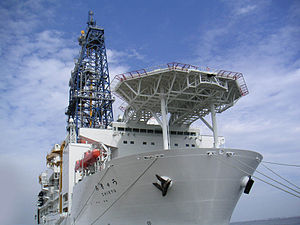- Chikyū
-

ChikyuCareer (  Japan)
Japan)Name: Chikyu Namesake: Japanese word for "Earth" Owner: CDEX Operator: CDEX Port of registry:  Yokosuka
YokosukaBuilder: Mitsui Engineering & Shipbuilding and Mitsubishi Heavy Industries Cost: 60 billion yen Laid down: 25 April 2001 Launched: 18 January 2002 Acquired: 29 July 2005 Homeport: Yokosuka, Kanagawa General characteristics [1] Class and type: NK (Nippon Kaiji Kyokai) Type: Ocean-going Drilling Vessel Displacement: 57,087 tons Length: 210 m Beam: 38 m Height: 130 m Draft: 9.2 m Depth: 16.2 m Propulsion: - 1 × 2,550kW side thruster
- 6 × 4,100kW azimuth thrusters
Speed: 12 knots Range: 14,800 nm Complement: 200 Crew: 100 Chikyū (ちきゅう) is a Japanese scientific drilling ship built for the Integrated Ocean Drilling Program (IODP). The vessel is designed to ultimately drill seven kilometres beneath the seabed, where the Earth's crust is much thinner, and into the Earth's mantle, deeper than any other hole drilled in the ocean thus far.
While the planned depth of the hole is significantly less than the Russian Kola Superdeep Borehole (which has already reached 12 km depth on land), the scientific results are expected to be much more interesting since the regions targeted by Chikyū include some of the most seismically-active regions of the world. Other deep holes have been drilled by the drill ship JOIDES Resolution during the Deep Sea Drilling Project and the Ocean Drilling Program.
Contents
Operation
The Japanese part of the IODP program was called Chikyū Hakken (地球発見 Chikyū Hakken), Japanese for "Earth Discovery". Chikyu is operated by the Centre for Deep Earth Research (CDEX), a subdivision of the Japan Agency for Marine-Earth Science and Technology (JAMSTEC). JAMSTEC also operates the DSV Shinkai, Earth Simulator supercomputer and other marine scientific research projects. CDEX is responsible for the services to support activities including on-board staffing, data management for core samples and logging; implements engineering site surveys; and conducts engineering developments. CDEX contracts with the Mantle Quest Japan Company for the navigation of the ship.
The Chikyū Hakken program is collaborated with foreign scientists from the United States, a consortium consisting of several European countries, Canada, China and South Korea.
Design
D/V Chikyu was built by the Mitsui Engineering & Shipbuilding and launched on January 18, 2002 in Nagasaki, Nagasaki.[2] The ship was outfitted by the Mitsubishi Heavy Industries and delivered to the JAMSTEC on July 29, 2005.[3]
The hull of the ship is 210 metres long, 38 metres in width, 16.2 metres high, and has an approximate gross tonnage of about 57,087 tons. The ship has a draft of 9.2 metres and a maximum cruising speed of 12 knots. The amidships derrick is 70 m high, and the top drive has a lifting capacity of 1,250 tons. Its complement of 150 crew are divided between 100 operators and 50 science personnel, with at seas crew changes handled by helicopter transfer.
Key innovations include a GPS system and six adjustable computer controlled azimuth thrusters (3.8 metres in diameter) that enable precise positioning to maintain a stable platform during deep water drilling. The maximum drilling water depth for riser drilling is 2,500 metres and can support a drill string up to 10,000 metres long.
History
On November 16, 2007 the project drilled into four of the six sites as planned, reaching 1,400 metres at the site where they plan to drill 6 kilometres. The first stage of four NanTroSEIZE Stages was completed in February 2008. The whole project is envisioned to be completed by 2012 [4]
The ship was damaged by the 2011 Tōhoku earthquake and tsunami on March 11, 2011. The ship was moored 300 m off the coast of Hachinohe, Aomori, but drifted by the tsunami and collided with a pier of the Hachinohe port. One of the six stabilizers was damaged and 1.5 meter hole was bored at the bottom. Local preliminary school children who visited the ship at the earthquake spent one night in the ship and were rescued by Japan Self-Defense Forces helicopters next day. The ship was repaired at a dock in Shingū, Wakayama and back to service in June 2011.[5]
In popular culture
The D/V Chikyū is featured and plays a pivotal role in the 2006 film Nihon Chinbotsu.
See also
- Scientific drilling program
- Scientific drilling ships
References
- ^ CHIKYU HAKKEN|ちきゅうデータ, JAMSTEC
- ^ 地球深部探査船「ちきゅう」に三井造船も貢献, Mitsui Engineering & Shipbuilding
- ^ Chikyū history page, accessed 2007-08-27
- ^ Chikyū's first mission complete Nature News, November 19, 2007
- ^ 地球深部探査船:「ちきゅう」修理完了…津波で損傷
External links
Categories:
Wikimedia Foundation. 2010.

